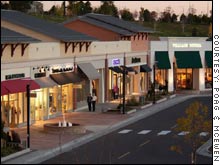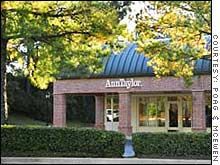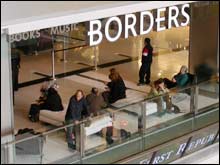NEW YORK (CNN/Money) -
It's got Ann Taylor, Pottery Barn, Williams-Sonoma and a Barnes & Noble, just like a regular suburban mall.
 |
|
| The Shops at Briargate in Colorado Springs. |
But take a closer look and you'll see leather lounge chairs in place of hard plastic benches, and natural sunshine instead of fluorescent tube lighting. Rather than a maze of escalators, you'll find tree-lined streets and beautifully designed stress-relieving fountains. There may even be a day-spa next to the Starbucks.
In other words, it's a really nice mall.
To many industry analysts, however, calling such a place a "mall" is like calling Secretariat a horse -- technically correct, but somehow insufficient.
So, to avoid that crass old M-word, high-end shopping venues now go by a new name. They're called "lifestyle centers," and they're popping up everywhere.
Lifestyle centers are a "boutique" shopping concept, according to Malachy Kavanagh, a spokesman for the International Council of Shopping Centers (ICSC). They are typically located near affluent residential neighborhoods, and feature fancy stores aimed at well-to-do consumers.
Unlike the massive, windowless 800,000 square foot suburban malls anchored by a discount or department store like Target (Research) or Sears (Research), lifestyle centers tend to be smaller, around 50,000 square feet. They're often open-air venues -- like a cute little village -- and are devoid of an anchor store.
Talbots, Coach, Chico's, Banana Republic, Sharper Image are the type of brands typically found in lifestyle centers. Besides stores, the centers feature upscale restaurants, coffee houses and fitness clubs.
It's all about the ambience, industry watchers say. And the prices, cynics might add.
Luxury boom drives building
The booming luxury goods market may have something to do with the recent proliferation of lifestyle centers.
 |
|
| Ann Taylor store at the The Shops center in Germantown, TN. |
"The growth of lifestyle centers is absolutely tied to the strong performance of the luxury sector," said Howard Davidowitz, president of Davidowitz & Associates, a New York-based retail consultancy and investment banking firm.
"Developers want to take shopping centers closer and closer to where the affluent, professional people live," he said. "Lifestyle centers are a means to that end. Their location is convenient to consumers because you can drive right up to the shops and park the car."
The number of lifestyle centers has quickly accelerated, from just 30 in 2002 to 120 at the end of 2004. Between 10 to 20 new centers are slated to open each year for the next two years. By contrast, only eight new regional malls are expected to open by 2006, according to ICSC.
"Upscale stores have been challenged to find new places outside of malls to set up shop," said Anita Kramer, director of retail development at the Urban Land Institute in Washington D.C. "This format creates a sort of shopping/leisure destination that's an extension of (a consumer's) personal lifestyle."
A sluggish environment for old-fashioned mall development is driving the trend, too. According to Davidowitz, "more malls are shutting down because of poor traffic trends than are being built."
"It's hard for property developers to find 70-80 acres of available land," said ICSC's Malachy Kavanaugh. "Even then, it takes 5 to 10 years to construct a regional mall with over 200 stores."
 |
|
| Lounging on leather at New York's Time Warner Center |
Terry McEwen is president of Tennessee-based developer Poag & McEwen, which industry experts credit for pioneering the lifestyle center format.
"This is the fastest growing retail format today," said McEwen. "Lifestyle centers are popular with mall operators because they're cheaper to operate than a traditional mall."
"The base rent for retailers may be the same as that in a mall but the average sales are higher," the developer noted. "And the shared maintenance cost of the common areas is one-third of similar costs at a traditional mall."
McEwen estimates lifestyle center sales to be about $400-$500 per square foot versus $330 a square foot at a traditional mall.
Poag & McEwen developed the country's first lifestyle shopping center called "The Shops of Saddle Creek" in Germantown, Tenn., in 1987. On average, the company plans to open two new centers a year in other parts of the country.
"These places are more fun and enticing for consumers," McEwen said. "The idea is to deliver a nurturing atmosphere for people and not just a shopping destination."
Just don't call it a mall.

|

